
Cephalissa is a monotypic moth genus in the family Geometridae. Its only species, Cephalissa siria, the orange triangle moth, is endemic to New Zealand. This species has been classified as nationally vulnerable by the Department of Conservation.

Paradetis is a monotypic moth genus in the family Geometridae. Its only species, Paradetis porphyrias, is endemic to New Zealand. The genus and species were first described by Edward Meyrick, the genus in 1885 and the species in 1883.

Bascantis is a genus of moths belonging to the family Tineidae. It contains only one species, Bascantis sirenica, that is endemic to New Zealand. This species is classified as "Data Deficient" by the Department of Conservation.

Austrocidaria parora is a species of moth of the family Geometridae. It is endemic to New Zealand.
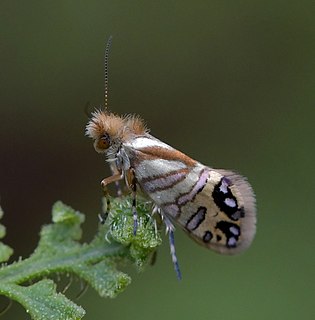
Sabatinca doroxena is a species of moth belonging to the family Micropterigidae. It is endemic to the North Island of New Zealand. This small moth has a colourful forewing pattern with stripes and dots evident. It has been hypothesised that the forewing pattern is intended to resemble a jumping spider in order to allow the adult moth to escape predation. Adults of this species are on the wing from the beginning of September until mid January. It prefers damp but sunny habitat in deep forest, at the forest edge or in open shrubland. Larvae feed on foliose liverwort species including on Heteroscyphus normalis. Adults of this species have been located at the blossoms of flowering Cordyline and Ranunculus species.

Izatha apodoxa is a moth of the family Oecophoridae. It is endemic to New Zealand, where it is known from scattered localities in the southern North Island. This species is variable in appearance and comes in two forms, a grey form and a black and white form. In the grey form it is very similar in appearance to I. notodoxa and in the black and white form to I. katadiktya. At present the larvae and biology of this species is unknown.
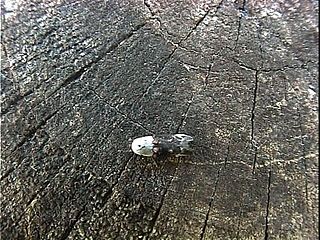
Trachypepla euryleucota is a species of moth in the family Oecophoridae. It is endemic to New Zealand and can be found throughout the country. They inhabit native forest and the larvae are leaf litter feeders and have also been found feeding on and in bird nests. Adults are on the wing from December to March, are nocturnal and are attracted to light. During the daylight hours they can be sometimes be observed resting on walls or fences. It has been hypothesised that the adults resemble an opening manuka flower bud or bird droppings in order to camouflage themselves from predators. The raised tufts on their forewings possibly also assist with camouflaging this moth when they rest on lichen.
Heterocrossa epomiana is a species moth in the family Carposinidae. It is endemic to New Zealand.

Heterocrossa gonosemana is a species of moth in the family Carposinidae. It is endemic to New Zealand.
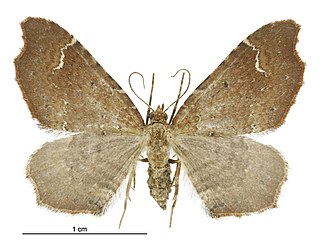
Asaphodes camelias is a species of moth in the family Geometridae. It is endemic to New Zealand and inhabits native forest. The adults of this species are on the wing from February to May and July to September.

Theoxena is a monotypic moth genus in the family Geometridae erected by Edward Meyrick in 1883. Its only species, Theoxena scissaria, was first described by Achille Guenée in 1868. It is endemic to New Zealand. This species has been classified as nationally vulnerable by the Department of Conservation.

Asaphodes cosmodora is a species of moth in the family Geometridae. This species is endemic to New Zealand and has been observed in the South Island. The adults of this species are on the wing in January and February.
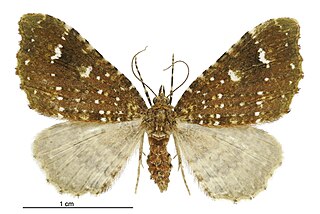
Asaphodes limonodes is a species of moth in the family Geometridae. It is endemic to New Zealand and is found in both the North and South Islands. This species inhabits damp native forest. Adults are on the wing from November until March.
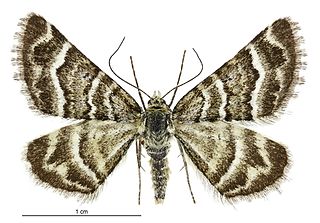
Notoreas paradelpha is a species of moth in the family Geometridae. It is endemic to New Zealand.
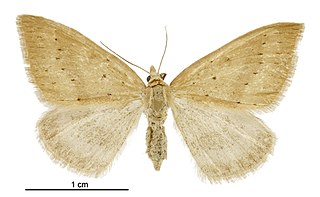
Asaphodes mnesichola is a species of moth in the family Geometridae. It is endemic to New Zealand and has been observed in the South Island. This species inhabits subalpine native scrub. Adults of this species are on the wing in January and February.

Tingena hemimochla is a species of moth in the family Oecophoridae. It is endemic to New Zealand and has been observed in the North Island. Adults of this species are on the wing from December until March.

Tingena letharga is a species of moth in the family Oecophoridae. It is endemic to New Zealand and has been observed in Otago. Adults are on the wing in December and January.

Asaphodes nephelias is a moth in the family Geometridae. It is endemic to New Zealand and has been observed in the South Island. The preferred habitat of this species is alpine tussock grasslands above native forest and in wetlands. The adults of this species are on the wing from January to March and are day flying. The female has brachypterous wings.

Asaphodes omichlias is a moth in the family Geometridae. It is endemic to New Zealand and has been observed in both the North and South Islands. This species inhabits rocky, open country in high mountains. Adults are on the wing in January and February. The appearance of the adult of this species is variable with some specimens having a paler and more grey appearance than the more usual brown appearance.

Asaphodes prasinias is a moth in the family Geometridae. It is endemic to New Zealand and has been found on both the North and South Islands. This species inhabits native forest including beech forest and subalpine scrub. The range of this species has reduced as this species is regarded as being locally extinct in the previously inhabited open non-forest habitats around Invercargill. Adults are on the wing from November to January.




















